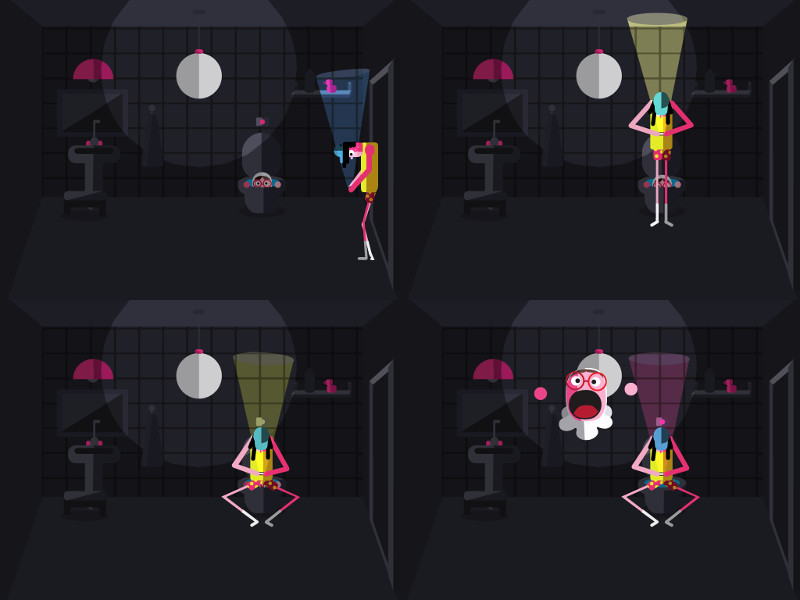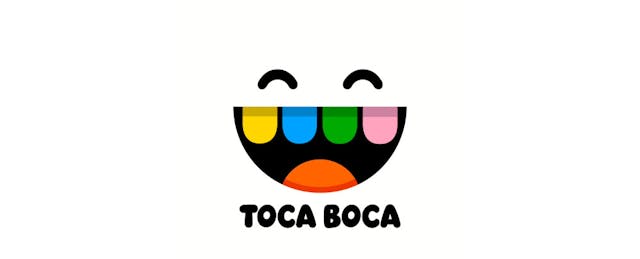Hey EdSurge readers. I’m back from vacation and ready with something fresh for your faces! You may know me for writing about educational games, but today I am writing about some apps that are not educational. Nor are they games. What are these apps, you ask? Why, they’re from Toca Boca, which just celebrated its 100 millionth download last Tuesday.
To understand the Toca Boca phenomenon, I purchased and installed eight of their apps for $2.99 each: Toca Hair Salon 2, Toca Kitchen 2, Toca Town, Toca Builders, Toca Boo, Toca Nature, Toca Train and Toca Kitchen. I played with each of them on my new iPad Mini 3 while on the BART train to work. (North Berkeley to Millbrae takes just under an hour.) Seven and a half minutes with each app doesn’t sound like much, but they’re very light and I exhausted the content before even reaching Daly City (48 minutes in).
If you are just interested in reading about the specific apps, feel free to scroll down to the "Not a Review" section. Otherwise, let’s take a look at the “educational” and “game” qualities of these non-educational-games.
Not Educational
I know what you’re thinking: Toca Boca apps have been topping the iOS Education charts since 2012. How can you say they are not educational? Well, it’s not me who says they aren’t educational. Just ask Toca Boca CEO, Björn Jeffrey who points out that many apps in the education category of the app store are not necessarily educational.
“Educational games” have somehow become synonymous with games that are safe and wholesome and are where parents often look for content for their kids. This is a trend that I dislike (why can’t there be an educational game with mature themes?) but it’s hard to argue with Toca Boca’s economic success.
Not a Game
Quick test: Which of these is not a game: SimCity, Minecraft or Pokémon? Take your time. Think about it. The answer might surprise you. Got your answer? It’s a trick question, none of these are games! Before you send that scathing tweet, hear me out.
According to game design legend and SimCity creator Will Wright, games, by definition, have intrinsic objectives and victory conditions. For example, in Chess, the objective is to capture your opponent’s king and in Super Mario World, the objective is to defeat Bowser in the final castle. Since SimCity does not actually have a victory condition, Wright famously categorizes it not as a game, but instead as a Software Toy. Minecraft falls into a similar category.
Pokémon is interesting in that it seems to present the victory condition of defeating the gym leaders, the Elite Four and your rival (whoops, spoiler alert), but the game (ummm, I mean, non-game) continues on after you do so. Is the goal then to catch every pokémon? To defeat your neighbor in PvP battle? To own a Shiny, Sassy, EV-trained Gardevoir? To complete the Nuzlocke Challenge? These are all perfectly valid objectives and can be considered extrinsically defined games. But much like a ball can be used to play various games but is not a game in and of itself, Pokémon is not, by definition, a game.
Tricky, huh?
Okay, now let’s look at Toca Hair Salon 2, perhaps the most popular Toca Boca app. Start it up and you are greeted by a friendly animated Toca Boca face (each of the apps has a unique animation), followed by a title screen, a catchy tune and a big Play button. Hit the Play button and you’re presented with six character portraits. Select one you like and you are ready to start.

Next you are taken to a counter in what looks more like a living room than a hair salon. The character you chose ambles amiably on screen and waits. There is no tutorial and the music has lapsed into silence. Before you lies a set of shears, clippers, a comb, a razor and a mysterious bottle simply labeled “Grow”. At this point, you are free to swipe the character’s hair away or grow it back at will. Swiping right with two fingers at the bottom of the screen will take you along the counter to tools that allow you to comb, color and wash the hair. Swiping left will allow you to adorn the character with accessories such as hats, glasses and hair bows.
Growing up, my older sister had a doll which, with the press of a lever, could grow or retract its multi-colored hair. This only lasted for a few days before the hair got too tangled to retract anymore. In a preschool class at my mother’s school (where she has just started her 26th year teaching kindergarten), there was a plastic head in which one could insert Play-Doh and squeeze out spaghetti strands of “hair.” Toca Hair Salon 2 offers the same general experience without the tangles or messy clean-up of these toys.
Thus, Toca Hair Salon 2 is a quintessential software toy. There is no text, no dialogue, no goals or objectives. Aside from the double-fingered swipes, every action is extremely intuitive. The characters react with delightful concern when you shave their heads and pleasure when you grow, comb and style their hair. If I were to critique Toca Hair Salon 2 as a game, I would bemoan the lack of content compared to a similarly priced product like Angry Birds. But again, it is not a game.
Not a Review
If you are reading this because you want to know whether to purchase a given Toca Boca app, then you might be disappointed. What follows are my thoughts and experiences as a grown man playing through various Toca Boca apps. Take them for what they are worth, but to be clear, they are my thoughts, not product reviews.
Toca Kitchen/Toca Kitchen 2

Pick a character to feed, pick some ingredients, prepare them with various kitchen implements (a pot of boiling water, a deep fryer, a cutting board, a blender, etc.), then feed them to the character. The gestures are tricky and the cooking possibilities are very limited, but overall this has the same feel as Toca Hair Salon. Toca Kitchen 2 has more ingredients and more cooking instruments than its predecessor. The game is quite charming in its details, like how the (presumably) carnivorous monster character will spit out his food in disgust when fed a carrot.
Toca Town

Toca Town presents a block of buildings, each of which can be entered. They each contain a plethora of characters and objects which can be held, moved, and otherwise interacted with — basically a digital dollhouse. Because this has a grander scope than the Kitchen or Hair Salon, the interactions are much shallower. Perhaps I did not spend enough time with the game, but I didn’t find any fun interactions with the characters and objects; they felt flat and dull. As a grown man, perhaps I am lacking the imagination necessary to appreciate the experience. But a scan through Toca Town’s reviews reveals that many players like it but also find it lacking. For a similar game that feels fresh and vibrant, check out Scribblenauts — a game where you can create virtually any object you can think of and interact with it realistically.
Toca Builders

At some point, I imagine the people at Toca Boca put a long list of popular children’s toys on a whiteboard and decided to make digital versions of as many of them as possible. Toca Builders is their attempt at a digital version of building blocks. You control a few different robots which can build, paint and move with cubes in various ways, but it’s not very intuitive or powerful. I really don’t like this one. If you have a child who is too young for Minecraft, perhaps this could be acceptable for building. But I would recommend handing the child actual blocks.
Toca Boo

In Toca Boo, you control a flying bespectacled child in a ghost costume. You wander a dark house searching for hiding places (marked by blue highlights) in which you can lie in wait for various family members to stroll by. If you click a family member while hidden, the child jumps out and they scream and run off in fright. Admittedly it’s pretty fun, but it does not have the same open, imaginative possibilities of other Toca Boca offerings.
Toca Nature

This is an interesting one. You are presented with a plot of land which you can terraform with mountains, ponds, and trees. Depending what landforms you create, different flora and fauna will appear, which you can collect and feed to animals higher up the food chain. For example, creating a pond will create fish, which you can feed to the bears that appear when you have enough of a particular type of tree. Much like Toca Town, the grand scope of Toca Nature makes the interactions much shallower. If there was more environmental cause-and-effect, it could possibly justify its categorization as an educational app.
Toca Train

I never really understood the appeal of trains to young (and old) kids. Perhaps the repetitive route offers a sense of comforting consistency (familiar to any parent whose young child chooses to watch his or her favorite movie for the umpteenth time instead of choosing a new one). Whatever it is, I was surprised when this was the app I spent the most time with. The experience is quite simple — you control a train which drives through a lush countryside making stops where it alternately loads and unloads passengers or cargo. I imagine that different Toca Boca apps will appeal to different kids and this happened to be my personal favorite.
Final Thoughts
Growing up, I spent a lot of time at my mother’s school on days off from my own school. When I was younger, I played with the kids during recess. In high school and college, I worked as a teaching assistant and yard supervisor. Among the many toys available to the kids, there was one computer in the preschool classroom; it was loaded with the point-and-click adventure, Putt-Putt Goes To The Moon. Kids would sign up for five minutes each of “computer time” to play the game, but every day the adventure would start again from the beginning. Despite playing the same introductory content over and over again, the kids loved it! When I was about 10, I had a good time beating the game myself, but the preschoolers were content to just poke around the beginning and watch the game react.
Björn Jeffrey theorizes that before the age of nine, children are much less concerned with objectives and are content to simply play for the sake of playing. Perhaps this can explain Toca Boca’s mass appeal with young children; the numbers seem to support his theory. Despite being not-quite-educational, this is an important lesson that parents, teachers and children’s software developers can all take away from Toca Boca.


